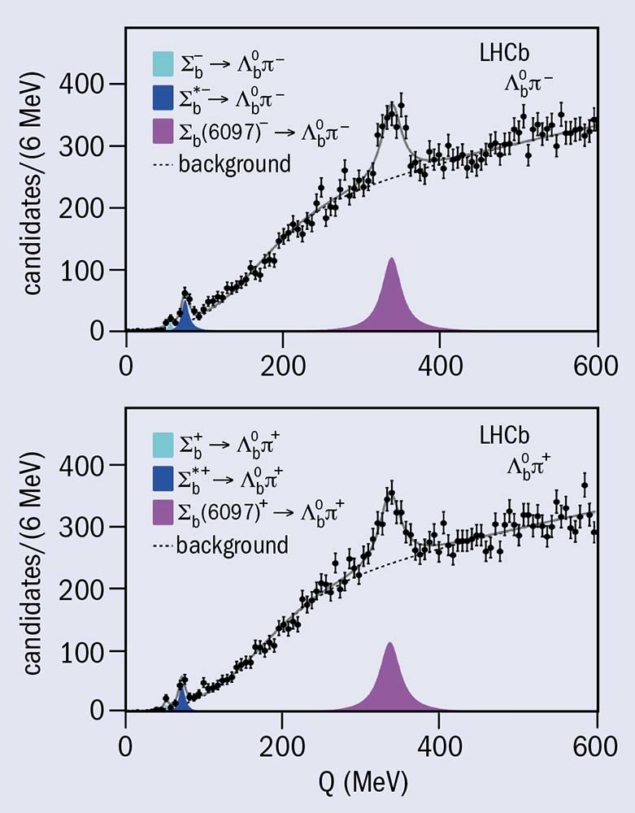
A report from the LHCb experiment
Although the quark model of hadrons is highly successful in describing how the quarks combine to form baryons and mesons, the internal mechanisms governing the dynamics of the strong force that binds quarks inside those hadrons are far from fully understood. By studying new hadronic resonances and their excited states, light can be shed on these mechanisms.
LHCb physicists have recently observed, for the first time, two new baryons. These states, named Σb(6097)+ and Σb(6097)−, occur as resonances appearing in the two-body system Λb0π±, which consists of a neutral Λb0 baryon and a charged π meson (see figure). The statistical significances of the observations are 12.7σ and 12.6σ, well above the threshold for discovery.
The new particles are members of the Σb family of baryons. Four of the six so-called ground states of this family, the Σb+, Σb–, Σb*+, and Σb*–, were previously discovered by the CDF collaboration at the Tevatron. LHCb also reports a study of the properties of these four ground states, measuring them with unprecedented statistics and improving the precision on their masses and widths by a factor of approximately five.
Establishing precisely how the new Σb(6097)+ and Σb(6097)− states fit into this family is not straightforward. Theoretical predictions for a number of excited Σb states exist, including five Σb(1P) states with expected masses close to the values seen by LHCb – though some of them may be difficult to observe experimentally. Since it’s possible for different excited states to have similar masses, it can’t be excluded that the newly observed mass peaks are actually superpositions of more than one state. Further input from theory, and future experimental studies with more data and in other final states, will help resolve this question.
The meson sector is also capable of providing surprising results. Evidence for another new hadron has recently been reported by LHCb in a Dalitz plot analysis of B0 decays to ηc(1S) K+ π−. A structure, which could be a new resonance in the ηc(1S) π− system, was detected with a significance of more than three standard deviations. While this does not meet the threshold for discovery, it is an intriguing hint and will be pursued with more data. If confirmed, this new Zc(4100)− resonance would be one of a small number of manifestly exotic mesons that cannot be described as a quark–anti-quark pair but must instead have a more complicated structure, such as being a tetraquark combination of two quarks and two antiquarks.
Further reading
LHCb Collaboration 2018 arXiv:1809.07752.
LHCb Collaboration 2018 arXiv:1809.07416.





